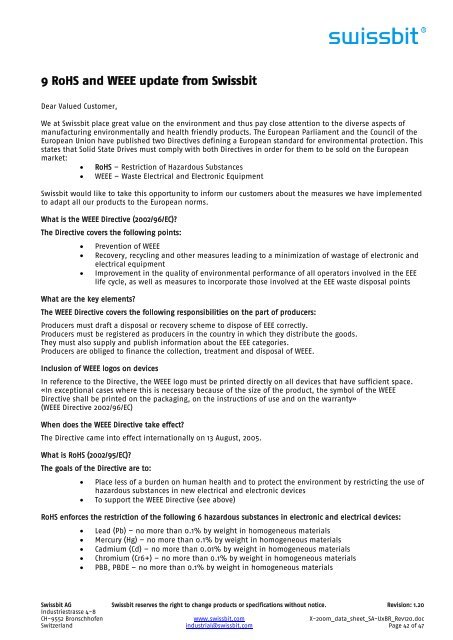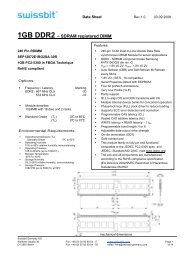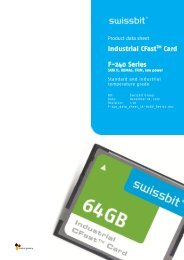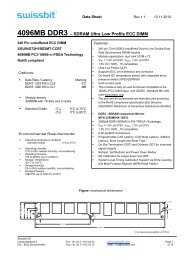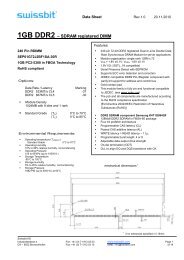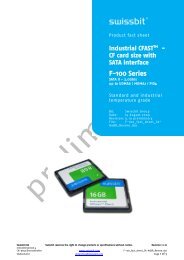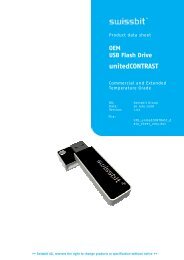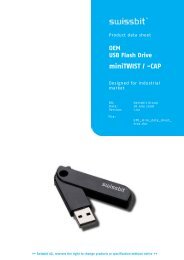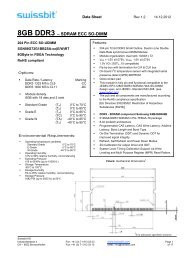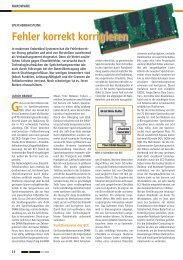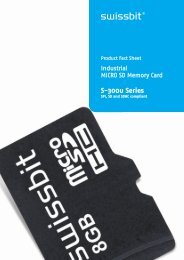X-200m Series - Swissbit
X-200m Series - Swissbit
X-200m Series - Swissbit
Create successful ePaper yourself
Turn your PDF publications into a flip-book with our unique Google optimized e-Paper software.
9 RoHS and WEEE update from <strong>Swissbit</strong><br />
Dear Valued Customer,<br />
We at <strong>Swissbit</strong> place great value on the environment and thus pay close attention to the diverse aspects of<br />
manufacturing environmentally and health friendly products. The European Parliament and the Council of the<br />
European Union have published two Directives defining a European standard for environmental protection. This<br />
states that Solid State Drives must comply with both Directives in order for them to be sold on the European<br />
market:<br />
RoHS – Restriction of Hazardous Substances<br />
WEEE – Waste Electrical and Electronic Equipment<br />
<strong>Swissbit</strong> would like to take this opportunity to inform our customers about the measures we have implemented<br />
to adapt all our products to the European norms.<br />
What is the WEEE Directive (2002/96/EC)?<br />
The Directive covers the following points:<br />
Prevention of WEEE<br />
Recovery, recycling and other measures leading to a minimization of wastage of electronic and<br />
electrical equipment<br />
Improvement in the quality of environmental performance of all operators involved in the EEE<br />
life cycle, as well as measures to incorporate those involved at the EEE waste disposal points<br />
What are the key elements?<br />
The WEEE Directive covers the following responsibilities on the part of producers:<br />
Producers must draft a disposal or recovery scheme to dispose of EEE correctly.<br />
Producers must be registered as producers in the country in which they distribute the goods.<br />
They must also supply and publish information about the EEE categories.<br />
Producers are obliged to finance the collection, treatment and disposal of WEEE.<br />
Inclusion of WEEE logos on devices<br />
In reference to the Directive, the WEEE logo must be printed directly on all devices that have sufficient space.<br />
«In exceptional cases where this is necessary because of the size of the product, the symbol of the WEEE<br />
Directive shall be printed on the packaging, on the instructions of use and on the warranty»<br />
(WEEE Directive 2002/96/EC)<br />
When does the WEEE Directive take effect?<br />
The Directive came into effect internationally on 13 August, 2005.<br />
What is RoHS (2002/95/EC)?<br />
The goals of the Directive are to:<br />
Place less of a burden on human health and to protect the environment by restricting the use of<br />
hazardous substances in new electrical and electronic devices<br />
To support the WEEE Directive (see above)<br />
RoHS enforces the restriction of the following 6 hazardous substances in electronic and electrical devices:<br />
Lead (Pb) – no more than 0.1% by weight in homogeneous materials<br />
Mercury (Hg) – no more than 0.1% by weight in homogeneous materials<br />
Cadmium (Cd) – no more than 0.01% by weight in homogeneous materials<br />
Chromium (Cr6+) – no more than 0.1% by weight in homogeneous materials<br />
PBB, PBDE – no more than 0.1% by weight in homogeneous materials<br />
<strong>Swissbit</strong> AG <strong>Swissbit</strong> reserves the right to change products or specifications without notice. Revision: 1.20<br />
Industriestrasse 4-8<br />
CH-9552 Bronschhofen www.swissbit.com X-<strong>200m</strong>_data_sheet_SA-UxBR_Rev120.doc<br />
Switzerland industrial@swissbit.com Page 42 of 47


